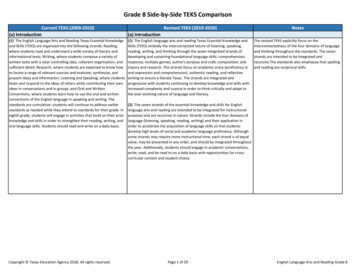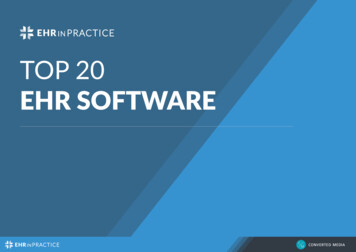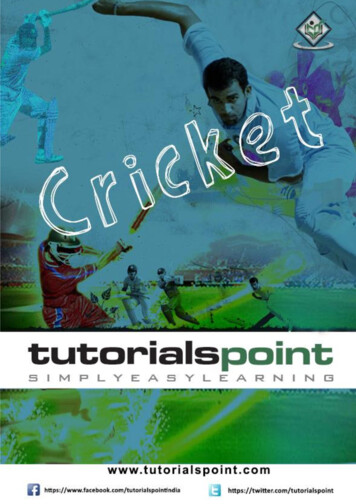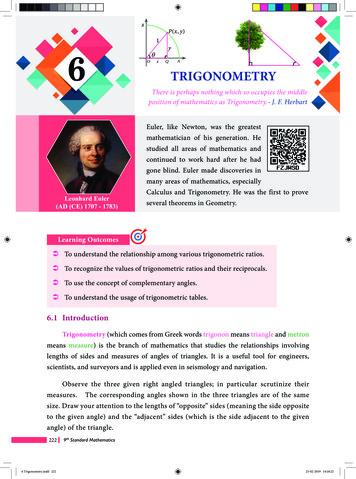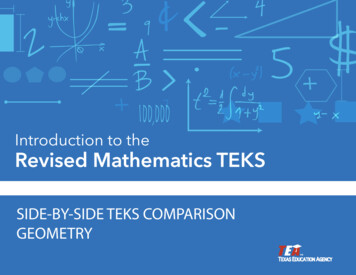
Transcription
SIDE-BY-SIDE TEKS COMPARISONGEOMETRY
The materials are copyrighted (c) and trademarked (tm) as the property of the Texas Education Agency (TEA) and may not be reproducedwithout the express written permission of TEA, except under the following conditions: Texas public school districts, charter schools, and Education Service Centers may reproduce and use copies of the Materialsand Related Materials for the districts’ and schools’ educational use without obtaining permission from TEA. Residents of the state of Texas may reproduce and use copies of the Materials and Related Materials for individual personal useonly without obtaining written permission of TEA. Any portion reproduced must be reproduced in its entirety and remain unedited, unaltered and unchanged in any way. No monetary charge can be made for the reproduced materials or any document containing them; however, a reasonablecharge to cover only the cost of reproduction and distribution may be charged.Private entities or persons located in Texas that are not Texas public school districts, Texas Education Service Centers, or Texas charterschools or any entity, whether public or private, educational or non-educational, located outside the state of Texas MUST obtain writtenapproval from TEA and will be required to enter into a license agreement that may involve the payment of a licensing fee or a royalty.For information contact:Office of Copyrights, Trademarks, License Agreements, and Royalties,Texas Education Agency,1701 N. Congress Ave., Austin, TX 78701-1494;phone: 512-463-9270 or 512-463-9437;email: copyrights@tea.state.tx.us. 2014 Texas Education Agency All Rights Reserved 2014. 2014 Texas Education Agency. All Rights Reserved 2014.Introduction to the Revised Mathematics TEKS: Side-By-Side TEKS Comparison
GeometryOld TEKSCurrent TEKS (2012)(a) Basic understandings.(1) Foundation concepts for high schoolmathematics. As presented in Grades K-8,the basic understandings of number,operation, and quantitative reasoning;patterns, relationships, and algebraicthinking; geometry; measurement; andprobability and statistics are essentialfoundations for all work in high schoolmathematics. Students continue to build onthis foundation as they expand theirunderstanding through other mathematicalexperiences.(b) Introduction.(1) The desire to achieve educationalexcellence is the driving force behind theTexas essential knowledge and skills formathematics, guided by the college andcareer readiness standards. By embeddingstatistics, probability, and finance, whilefocusing on fluency and solidunderstanding, Texas will lead the way inmathematics education and prepare allTexas students for the challenges they willface in the 21st century.(a) Basic understandings.(2) Geometric thinking and spatialreasoning. Spatial reasoning plays a criticalrole in geometry; geometric figures providepowerful ways to represent mathematicalsituations and to express generalizationsabout space and spatial relationships.Students use geometric thinking tounderstand mathematical concepts and therelationships among them.(a) Basic understandings.(3) Geometric figures and their properties.Geometry consists of the study ofgeometric figures of zero, one, two, andthree dimensions and the relationshipsamong them. Students study propertiesand relationships having to do with size,shape, location, direction, and orientationof these figures.(a) Basic understandings.(4) The relationship between geometry,other mathematics, and other disciplines.Geometry can be used to model andrepresent many mathematical and realworld situations. Students perceive theconnection between geometry and the realand mathematical worlds and usegeometric ideas, relationships, andproperties to solve problems.Supporting Information(b) Introduction.(3) In Geometry, students will build on theknowledge and skills for mathematics inKindergarten-Grade 8 and Algebra I tostrengthen their mathematical reasoningskills in geometric contexts. Within thecourse, students will begin to focus onmore precise terminology, symbolicrepresentations, and the development ofproofs. Students will explore conceptscovering coordinate and transformationalgeometry; logical argument andconstructions; proof and congruence;similarity, proof, and trigonometry; twoand three- dimensional figures; circles; andprobability. Students will connect previousknowledge from Algebra I to Geometrythrough the coordinate andtransformational geometry strand. In thelogical arguments and constructions strand,students are expected to create formalconstructions using a straight edge andcompass. Though this course is primarilyEuclidean geometry, students shouldcomplete the course with an understandingthat non-Euclidean geometries exist. Inproof and congruence, students will usedeductive reasoning to justify, prove andapply theorems about geometric figures.Throughout the standards, to “prove”means a formal proof to be shown in aparagraph, a flow chart, or two-columnformats. Proportionality is the unifyingcomponent of the similarity, proof andThe definition of a well-balanced mathematicscurriculum has expanded to include the CCRS.A focus on mathematical fluency and solidunderstanding allows for rich exploration of theprimary focal points.The 2012 paragraph that highlights morespecifics about Geometry mathematics contentfollows the paragraph about the mathematicalprocess standards. This supports the notionthat the TEKS should be learned in a way thatintegrates the mathematical process standardsin an effort to develop fluency.The 2012 paragraph has been updated to alignto the 2012 Geometry mathematics TEKS.The 2012 paragraph summarizes the keyconcepts found in Geometry while makingconnections to prior content and the Collegeand Career Readiness Standards.Content that is deleted by 2012 TEKS – Content that remains or is clarified in 2012 TEKS ( 2014 Texas Education Agency. All Rights Reserved 2014.Notes Stay) ( Addition) ( Deletion) Content that is new in 2012 TEKS Introduction to the Revised Mathematics TEKS: Side-by-Side TEKS Comparison1
GeometryOld TEKS(a) Basic understandings.(5) Tools for geometric thinking.Techniques for working with spatial figuresand their properties are essential inunderstanding underlying relationships.Students use a variety of representations(concrete, pictorial, numerical, symbolic,graphical, and verbal), tools, andtechnology (including, but not limited to,calculators with graphing capabilities, datacollection devices, and computers) to solvemeaningful problems by representing andtransforming figures and analyzingrelationships.(a) Basic understandings.(6) Underlying mathematical processes.Many processes underlie all content areasin mathematics. As they do mathematics,students continually use problem-solving,language and communication, connectionswithin and outside mathematics, andreasoning (justification and proof).Students also use multiple representations,technology, applications and modeling, andnumerical fluency in problem solvingcontexts.Current TEKS (2012)Supporting Informationtrigonometry strand. Students will use theirproportional reasoning skills to prove andapply theorems and solve problems in thisstrand. The two- and three-dimensionalfigure strand focuses on the application offormulas in multi-step situations sincestudents have developed backgroundknowledge in two-and three-dimensionalfigures. Using patterns to identifygeometric properties, students will applytheorems about circles to determinerelationships between special segments andangles in circles. Due to the emphasis ofprobability and statistics in the college andcareer readiness standards, standardsdealing with probability have been added tothe geometry curriculum to ensurestudents have proper exposure to thesetopics before pursuing their post-secondaryeducation.(b) Introduction.(2) The process standards describe ways inwhich students are expected to engage inthe content. The placement of the processstandards at the beginning of theknowledge and skills listed for each gradeand course is intentional. The processstandards weave the other knowledge andskills together so that students may besuccessful problem solvers and usemathematics efficiently and effectively indaily life. The process standards areintegrated at every grade level and course.When possible, students will applymathematics to problems arising ineveryday life, society, and the workplace.Students will use a problem-solving modelthat incorporates analyzing giveninformation, formulating a plan or strategy,determining a solution, justifying thesolution, and evaluating the problemsolving process and the reasonableness ofthe solution. Students will selectappropriate tools such as real objects,manipulatives, paper and pencil, andtechnology and techniques such as mentalmath, estimation, and number sense tosolve problems. Students will effectivelycommunicate mathematical ideas,reasoning, and their implications usingmultiple representations such as symbols,diagrams, graphs, and language. Studentswill use mathematical relationships togenerate solutions and make connectionsand predictions. Students will analyzemathematical relationships to connect andThis 2012 paragraph occurs second in theRevised TEKS (2012) instead of sixth as in thecurrent TEKS. This highlights the continuedemphasis on process skills that now continuefrom kindergarten through high schoolmathematics.Content that is deleted by 2012 TEKS – Content that remains or is clarified in 2012 TEKS ( 2014 Texas Education Agency. All Rights Reserved 2014.Notes Stay) ( Addition) ( Deletion) Content that is new in 2012 TEKS Introduction to the Revised Mathematics TEKS: Side-by-Side TEKS Comparison2
GeometryOld TEKSCurrent TEKS (2012)Supporting InformationNotescommunicate mathematical ideas. Studentswill display, explain, or justify mathematicalideas and arguments using precisemathematical language in written or oralcommunication.(b) Introduction.(4) These standards are meant to provideclarity and specificity in regards to thecontent covered in the high schoolgeometry course. These standards are notmeant to limit the methodologies used toconvey this knowledge to students.Though the standards are written in aparticular order, they are not necessarilymeant to be taught in the given order. Inthe standards, the phrase "to solveproblems" includes both contextual andnon-contextual problems unlessspecifically stated.(5) Statements that contain the word“including” reference content that must bemastered, while those containing thephrase “such as” are intended as possibleillustrative examples.Content that is deleted by 2012 TEKS – Content that remains or is clarified in 2012 TEKS ( 2014 Texas Education Agency. All Rights Reserved 2014. Stay) ( Addition) ( Deletion) Content that is new in 2012 TEKS Introduction to the Revised Mathematics TEKS: Side-by-Side TEKS Comparison3
GeometryOld TEKS: Geometric structureG(1)(A) Geometric structure. The studentunderstands the structure of, and relationshipswithin, an axiomatic system. – The student is expected to develop anawareness of the structure of amathematical system, connectingdefinitions, postulates, logical reasoning,and theorems.Supporting InformationG(4)(A) Logical argument andconstructions. The student uses the processskills with deductive reasoning to understandgeometric relationships.The student is expected to distinguishbetween undefined terms, definitions,postulates, conjectures, and theorems.G(1)(B) Geometric structure. The studentunderstands the structure of, and relationshipswithin, an axiomatic system.G(1)(C) Geometric structure. The studentunderstands the structure of, and relationshipswithin, an axiomatic system.The student is expected to compare andcontrast the structures and implications ofEuclidean and non-Euclidean geometries.The student is expected to useconstructions to explore attributes ofgeometric figures and to makeconjectures about geometricrelationships.NotesSpecificity has been added with theclarification of changing “connecting” to“distinguish between.”Specificity has been added to include theundefined terms. These terms are point, line,and plane.Logical reasoning is implicit withinmathematical process standards G(1)(B),G(1)(D), G(1)(E), G(1)(F), and G(1)(G).This skill is not included within the RevisedTEKS (2012).The student is expected to recognize thehistorical development of geometricsystems and know mathematics isdeveloped for a variety of purposes.G(2)(A) Geometric structure. The studentanalyzes geometric relationships in order tomake and verify conjectures. Current TEKS (2012)G(4)(D) Logical argument andconstructions. The student uses the processskills with deductive reasoning to understandgeometric relationships.The student is expected to comparegeometric relationships betweenEuclidean and spherical geometries,including parallel lines and the sum of theangles in a triangle.G(5)(C) Logical argument andconstructions. The student uses constructionsto validate conjectures about geometricfigures.The student is expected to use theconstructions of congruent segments,congruent angles, angle bisectors, andperpendicular bisectors to makeconjectures about geometricrelationships.Content that is deleted by 2012 TEKS – Content that remains or is clarified in 2012 TEKS ( 2014 Texas Education Agency. All Rights Reserved 2014.Specificity has been added with theclarification of changing “non-Euclideangeometries” to “spherical geometries.”Specificity has also been added through theinclusion of “parallel lines and the sum of theangles in a triangle” when comparingrelationships between Euclidean and sphericalgeometries.Specificity has been added through theidentification of constructions a student maybe expected to use when making conjecturesabout geometric relationships.When paired with mathematical processstandard G(1)(F), the expectation is thatstudents use constructions to explore andvalidate conjectures about the attributes ofgeometric figures. Stay) ( Addition) ( Deletion) Content that is new in 2012 TEKS Introduction to the Revised Mathematics TEKS: Side-by-Side TEKS Comparison4
GeometryOld TEKS: Geometric structureG(2)(B) Geometric structure. The studentanalyzes geometric relationships in order tomake and verify conjectures. The student is expected to makeconjectures about angles, lines, polygons,circles, and three-dimensional figures anddetermine the validity of the conjectures,choosing from a variety of approachessuch as coordinate, transformational, oraxiomatic.G(3)(A) Geometric structure. The studentapplies logical reasoning to justify and provemathematical statements.The student is expected to determine thevalidity of a conditional statement, itsconverse, inverse, and contrapositive.G(3)(B) Geometric structure. The studentapplies logical reasoning to justify and provemathematical statements. The student isexpected to:The student is expected to construct andjustify statements about geometricfigures and their properties.Current TEKS (2012)Supporting InformationG(5)(A) Logical argument andconstructions. The student uses constructionsto validate conjectures about geometricfigures.The student is expected to investigatepatterns to make conjectures aboutgeometric relationships, including anglesformed by parallel lines cut by atransversal, criteria required for trianglecongruence, special segments oftriangles, diagonals of quadrilaterals,interior and exterior angles of polygons,and special segments and angles of circleschoosing from a variety of tools.G(4)(B) Logical argument andconstructions. The student uses the processskills with deductive reasoning to understandgeometric relationships.The student is expected to identify anddetermine the validity of the converse,inverse, and contrapositive of aconditional statementand recognize the connection between abiconditional statement and a trueconditional statement with a trueconverse.G(5)(B) Logical argument andconstructions. The student uses constructionsto validate conjectures about geometricfigures.The student is expected to constructcongruent segments, congruent angles, asegment bisector, an angle bisector,perpendicular lines, the perpendicularbisector of a line segment, and a lineparallel to a given line through a point noton a line using a compass and astraightedge.Content that is deleted by 2012 TEKS – Content that remains or is clarified in 2012 TEKS ( 2014 Texas Education Agency. All Rights Reserved 2014.NotesSpecificity regarding the use of constructionsto investigate patterns and make conjectureshas been added.When paired with mathematical processstandards G(1)(D), G(1)(E), G(1)(F), andG(1)(G) the expectation is that studentsdetermine the validity of their conjectures.Specificity has been added regarding geometricrelationships.In the current TEKS, it is implied that studentswould be given the converse, inverse, andcontrapositive. The skill of identifying theconverse, inverse, and contrapositive of aconditional statement was implicit in thecurrent TEKS. The revised SE makes theseskills explicit.The skill of connecting a biconditionalstatement and a true conditional statementwith a true converse has been added.The use of constructions has been madeexplicit in the revised SE G(5)(B).Specificity has been added regarding the useof a compass and straightedge forconstructions.Specificity has added regarding the figures astudent is expected to construct. Stay) ( Addition) ( Deletion) Content that is new in 2012 TEKS Introduction to the Revised Mathematics TEKS: Side-by-Side TEKS Comparison5
GeometryOld TEKS: Geometric structureCurrent TEKS (2012)Supporting InformationG(5)(C) Logical argument andconstructions. The student uses constructionsto validate conjectures about geometricfigures.Specificity has been added to revised SEG(5)(C) regarding the geometric figures aboutwhich students are expected to makeconjectures.NotesThe student is expected to use theconstructions of congruent segments,congruent angles, angle bisectors, andperpendicular bisectors to makeconjectures about geometricrelationships.G(5)(D) Logical argument andconstructions. The student uses constructionsto validate conjectures about geometricfigures.The student is expected to verify theTriangle Inequality theorem usingconstructions and apply the theorem tosolve problems. –––G(3)(C) Geometric structure. The studentapplies logical reasoning to justify and provemathematical statements.The student is expected to use logicalreasoning to prove statements are trueand find counter examples to disprovestatements that are false.G(4)(C) Logical argument andconstructions. The student uses the processskills with deductive reasoning to understandgeometric relationships.The student is expected to verify that aconjecture is false using acounterexample.G(3)(D) Geometric structure. The studentapplies logical reasoning to justify and provemathematical statements.The student is expected to use inductivereasoning to formulate a conjecture.The foundation for the Triangle InequalityTheorem begins in grade 6, where studentsverify that a given set of lengths could form atriangle:Expressions, equations, and relationships6(8)(A)When paired with G(1)(D), G(1)(E), G(1)(F),or G(1)(G), the expectation is that studentsuse logical reasoning to verify the truthfulnessof any conjecture.The revised SE emphasizes that students areexpected to use a counterexample to verifythat a conjecture is false.Though the content of this SE is explicitlyremoved, it is implicitly addressed throughG(1)(D), G(1)(E), G(1)(F), and G(1)(G). Wheninstruction integrates these mathematicalprocess standards with other contentstandards, students may be expected to useinductive reasoning to formulate a conjecture.Though the content of this SE is explicitlyremoved, it is implicitly addressed throughG(1)(D), G(1)(E), G(1)(F), and G(1)(G). Wheninstruction integrates these mathematicalprocess standards with other contentstandards, students may be expected to usedeductive reasoning to formulate a conjecture.G(3)(E) Geometric structure. The studentapplies logical reasoning to justify and provemathematical statements.The student is expected to use deductivereasoning to prove a statement.G(4) Geometric structure. The student usesa variety of representations to describegeometric relationships and solve problems.The use of multiple representations has beenincluded through the mathematical processstandards, G(1)(C) and G(1)(D).The student is expected to select anappropriate representation (concrete,pictorial, graphical, verbal, or symbolic) inorder to solve problems.Content that is deleted by 2012 TEKS – Content that remains or is clarified in 2012 TEKS ( 2014 Texas Education Agency. All Rights Reserved 2014.Revised SE G(5)(D) makes the verification ofthe Triangle Inequality theorem usingconstructions explicit. Stay) ( Addition) ( Deletion) Content that is new in 2012 TEKS Introduction to the Revised Mathematics TEKS: Side-by-Side TEKS Comparison6
GeometryOld TEKS: Geometric patterns G(5)(A) Geometric patterns. The studentuses a variety of representations to describegeometric relationships and solve problems.The student is expected to use numericand geometric patterns to developalgebraic expressions representinggeometric properties.G(5)(B) Geometric patterns. The studentuses a variety of representations to describegeometric relationships and solve problems.The student is expected to use numericand geometric patterns to makegeneralizations about geometricproperties, including properties ofpolygons, ratios in similar figures andsolids, and angle relationships in polygonsand circles.G(5)(C) Geometric patterns. The studentuses a variety of representations to describegeometric relationships and solve problems. The student is expected to use propertiesof transformations and their compositionsto make connections betweenmathematics and the real world, such astessellations.Current TEKS (2012)Supporting InformationG(5)(A) Logical argument andconstructions. The student usesconstructions to validate conjectures aboutgeometric figures.The student is expected to investigatepatterns to make conjectures aboutgeometric relationships, including anglesformed by parallel lines cut by atransversal, criteria required for trianglecongruence, special segments oftriangles, diagonals of quadrilaterals,interior and exterior angles of polygons,and special segments and angles of circleschoosing from a variety of tools.G(3)(A) Coordinate and transformationalgeometry. The student uses the process skillsto generate and describe rigid transformations(translation, reflection, and rotation) and nonrigid transformations (dilations that preservesimilarity and reductions and enlargementsthat do not preserve similarity).The student is expected to describe andperform transformations of figures in aplane using coordinate notation,Content that is deleted by 2012 TEKS – Content that remains or is clarified in 2012 TEKS ( 2014 Texas Education Agency. All Rights Reserved 2014.NotesThe current SEs G(5)(A) and G(5)(B) werecombined to form revised SE G(5)(A).“Patterns” include numeric and geometricproperties.“Conjectures” is a better word choice than“generalizations” as it is consistent with theacademic language of geometry.“Relationships” may or may not includealgebraic expressions representing properties.Specificity is added to the revised SE regardingthe geometric relationships that students mayexpected to investigate.Similar figures and solids are addressed in the“Similarity, proof and trigonometry” strand.The revised SE G(3)(A) extends past rotationsfrom in grade 8 and explicitly states sional shapes8(10)(A)8(10)(B)8(10)(C)Specificity has been added for students to beable to “describe” and “perform”transformations. Stay) ( Addition) ( Deletion) Content that is new in 2012 TEKS Introduction to the Revised Mathematics TEKS: Side-by-Side TEKS Comparison7
GeometryOld TEKS: Geometric patternsCurrent TEKS (2012)Supporting InformationG(3)(B) Coordinate and transformationalgeometry. The student uses the process skillsto generate and describe rigid transformations(translation, reflection, and rotation) and nonrigid transformations (dilations that preservesimilarity and reductions and enlargementsthat do not preserve similarity).The student is expected to determine theimage or pre-image of a given twodimensional figure under a composition ofrigid transformations, a composition ofnon-rigid transformations, and acomposition of both, including dilationswhere the center can be any point in theplane.NotesIn grade 8, students graph and algebraicallyrepresent single transformations. For example,students are expected to describe a translationand a reflection algebraically such as(x, y ) (x 3, y 2) to describe translations.The revised Geometry SEs extends to includegraphing and describing a composition oftransformations.Dilations are included with center of dilationother than origin. In grade 8, students gainexperience with dilations with the origin as thecenter.Rotations may or may not be about the origin.In grade 8, students differentiate betweentransformations that preserve congruence andthose that do not. Rigid and non-rigidtransformations are explicitly included in therevised Geometry SEs.When paired with process standard G(1)(A),tessellations could be included.G(3)(C) Coordinate and transformationalgeometry. The student uses the process skillsto generate and describe rigid transformations(translation, reflection, and rotation) and nonrigid transformations (dilations that preservesimilarity and reductions and enlargementsthat do not preserve similarity).G(5)(D) Geometric patterns. The studentuses a variety of representations to describegeometric relationships and solve problems. The student is expected to identify andapply patterns from right triangles tosolve meaningful problems, includingspecial right triangles (45-45-90 and 3060-90) and triangles whose sides arePythagorean triples.The student is expected to identify thesequence of transformations that willcarry a given pre-image onto an image onand off the coordinate plane.G(9)(B) Similarity, proof, andtrigonometry. The student uses the processskills to understand and apply relationships inright triangles.The student is expected to apply therelationships in special right triangles(30 –60 –90 and 45 –45 –90 ) and thePythagorean theorem, includingPythagorean triples, to solve problems.Content that is deleted by 2012 TEKS – Content that remains or is clarified in 2012 TEKS ( 2014 Texas Education Agency. All Rights Reserved 2014.Students are expected to identify the sequenceof transformation performed for a given preimage and image. The transformations may ormay not be represented on a coordinate plane.The revised SE focuses on applyingrelationships to solve problems involving righttriangles.When paired with mathematical processstandard G(1)(F), the expectation is thatstudents analyze the relationships in specialright triangles and Pythagorean triples. Stay) ( Addition) ( Deletion) Content that is new in 2012 TEKS Introduction to the Revised Mathematics TEKS: Side-by-Side TEKS Comparison8
GeometryOld TEKS: Dimensionality and thegeometry of location G(6)(A) Dimensionality and the geometryof location. The student analyzes therelationship between three-dimensionalgeometric figures and related two-dimensionalrepresentations and uses these representationsto solve problems.The student is expected to describe anddraw the intersection of a given planewith various three-dimensional geometricfigures.–Current TEKS (2012)Supporting InformationG(10)(A) Two-dimensional and threedimensional figures. The student uses theprocess skills to recognize characteristics anddimensional changes of two- and threedimensional figures.The student is expected to identify theshapes of two-dimensional cross-sectionsof prisms, pyramids, cylinders, cones, andspheresand identify three-dimensional objectsgenerated by rotations of twodimensional shapes. G(6)(C) Dimensionality and the geometryof location. The student analyzes therelationship between three-dimensionalgeometric figures and related two-dimensionalrepresentations and uses these representationsto solve problems.The student is expected to useorthographic and isometric views ofthree-dimensional geometric figures torepresent and construct threedimensional geometric figures and solveproblems.G(7)(A) Dimensionality and the geometryof location. The student understands thatcoordinate systems provide convenient andefficient ways of representing geometricfigures and uses them accordingly.The student is expected to use one- andtwo-dimensional coordinate systems torepresent points, lines, rays, linesegments, and figures.The revised SE adds specificity through theidentification of two-dimensional cross sectionsfor specific geometric figures.The revised SE includes identifying 3-D objectsgenerated by rotations of 2-D shapes.This skill is not included explicitly within theRevised TEKS (2012). In grade 7, with7(9)(D), students are expected to solveproblems involving the lateral and totalsurface area of a rectangular prism,rectangular pyramid, triangular prism, andtriangular pyramid by determining the area ofthe shape’s net. Students may or may not beexpected to make the net of a threedimensional figure.G(6)(B) Dimensionality and the geometryof location. The student analyzes therelationship between three-dimensionalgeometric figures and related two-dimensionalrepresentations and uses these representationsto solve problems.The student is expected to use nets torepresent and construct threedimensional geometric figures.–NotesThis skill is not included within the RevisedTEKS (2012).G(4)(A) Logical argument andconstructions. The student uses the processskills with deductive reasoning to understandgeometric relationships.The student is expected to distinguishbetween unde
Introduction to the Revised Mathematics TEKS: Side-By-Side TEKS Comparison . Geometry . Old. TEKS . Current; TEKS (2012) Supporting Information . Notes (a) Basic understandings. (1) Foundation concepts for high school mathematics. As presented in Grades K -8, the basic understandings of number,
